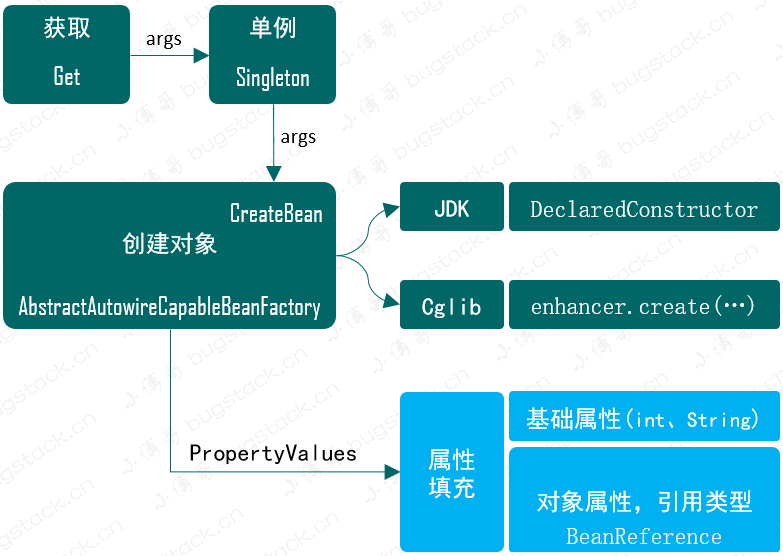關於Spring Bean實例過程中使用反射和遞歸處理的Bean屬性填充問題
一、前言
超賣、掉單、冪等,你的程序總是不抗揍!
想想,運營已經對外宣傳瞭七八天的活動,滿心歡喜的等著最後一天頁面上線對外瞭,突然出現瞭一堆異常、資損、閃退,而用戶流量稍縱即逝,最後想死的心都有!
就編程開發來講,丟三落四、亂碼七糟,可能這就是大部分初級程序員日常開發的真實寫照,在即使有測試人員驗證的情況下,也會出現帶Bug上線的現象,隻不過是當時沒有發現而已!因為是人寫代碼,就一定會有錯誤,即使是老碼農
就程序Bug來講,會包括產品PRD流程上的Bug、運營配置活動時候的Bug、研發開發時功能實現的Bug、測試驗證時漏掉流程的Bug、上線過程中運維服務相關配置的Bug,而這些其實都可以通過制定的流程規范和一定的研發經驗積累,慢慢盡可能減少。
而另外一類是溝通留下的Bug,通常情況下業務提需求、產品定方案、研發做實現,最終還要有UI、測試、運營、架構等等各個環節的人員參與到一個項目的承接、開發到上線運行,而在這一群人需要保持一個統一的信息傳播其實是很難的。比如在項目開發中期,運營給產品說瞭一個新增的需求,產品覺得功能也不大,隨即找到對應的前端研發加個邏輯,但沒想到可能也影響到瞭後端的開發和測試的用例。最後功能雖然是上線瞭,可並不在整個產研測的需求覆蓋度范圍裡,也就隱形的埋下瞭一個坑。
所以,如果你想讓你的程序很抗揍,接的住農夫三拳,那麼你要做的就不隻是一個單純的搬磚碼農!
二、目標
首先我們回顧下這幾章節都完成瞭什麼,包括:實現一個容器、定義和註冊Bean、實例化Bean,按照是否包含構造函數實現不同的實例化策略,那麼在創建對象實例化這我們還缺少什麼?其實還缺少一個關於類中是否有屬性的問題,如果有類中包含屬性那麼在實例化的時候就需要把屬性信息填充上,這樣才是一個完整的對象創建。
對於屬性的填充不隻是 int、Long、String,還包括還沒有實例化的對象屬性,都需要在 Bean 創建時進行填充操作。不過這裡我們暫時不會考慮 Bean 的循環依賴,否則會把整個功能實現撐大,這樣新人學習時就把握不住瞭,待後續陸續先把核心功能實現後,再逐步完善
三、設計
鑒於屬性填充是在 Bean 使用 newInstance 或者 Cglib 創建後,開始補全屬性信息,那麼就可以在類 AbstractAutowireCapableBeanFactory 的 createBean 方法中添加補全屬性方法。這部分大傢在實習的過程中也可以對照Spring源碼學習,這裡的實現也是Spring的簡化版,後續對照學習會更加易於理解

- 屬性填充要在類實例化創建之後,也就是需要在
AbstractAutowireCapableBeanFactory的 createBean 方法中添加applyPropertyValues操作。 - 由於我們需要在創建Bean時候填充屬性操作,那麼就需要在 bean 定義 BeanDefinition 類中,添加 PropertyValues 信息。
- 另外是填充屬性信息還包括瞭 Bean 的對象類型,也就是需要再定義一個 BeanReference,裡面其實就是一個簡單的 Bean 名稱,在具體的實例化操作時進行遞歸創建和填充,與 Spring 源碼實現一樣。Spring 源碼中 BeanReference 是一個接口
四、實現
1. 工程結構
small-spring-step-04
└── src
├── main
│ └── java
│ └── cn.bugstack.springframework.beans
│ ├── factory
│ │ ├── factory
│ │ │ ├── BeanDefinition.java
│ │ │ ├── BeanReference.java
│ │ │ └── SingletonBeanRegistry.java
│ │ ├── support
│ │ │ ├── AbstractAutowireCapableBeanFactory.java
│ │ │ ├── AbstractBeanFactory.java
│ │ │ ├── BeanDefinitionRegistry.java
│ │ │ ├── CglibSubclassingInstantiationStrategy.java
│ │ │ ├── DefaultListableBeanFactory.java
│ │ │ ├── DefaultSingletonBeanRegistry.java
│ │ │ ├── InstantiationStrategy.java
│ │ │ └── SimpleInstantiationStrategy.java
│ │ └── BeanFactory.java
│ ├── BeansException.java
│ ├── PropertyValue.java
│ └── PropertyValues.java
└── test
└── java
└── cn.bugstack.springframework.test
├── bean
│ ├── UserDao.java
│ └── UserService.java
└── ApiTest.java
工程源碼:
《Spring 手擼專欄》學習源碼介紹
專欄地址:https://bugstack.cn/itstack/spring.html
源碼地址:https://github.com/fuzhengwei/small-spring
Spring Bean 容器類關系,如圖 5-2

- 本章節中需要新增加3個類,
BeanReference(類引用)、PropertyValue(屬性值)、PropertyValues(屬性集合),分別用於類和其他類型屬性填充操作。 - 另外改動的類主要是
AbstractAutowireCapableBeanFactory,在 createBean 中補全屬性填充部分。
2. 定義屬性
cn.bugstack.springframework.beans.PropertyValue
public class PropertyValue {
private final String name;
private final Object value;
public PropertyValue(String name, Object value) {
this.name = name;
this.value = value;
}
// ...get/set
}
cn.bugstack.springframework.beans.PropertyValues
public class PropertyValues {
private final List<PropertyValue> propertyValueList = new ArrayList<>();
public void addPropertyValue(PropertyValue pv) {
this.propertyValueList.add(pv);
}
public PropertyValue[] getPropertyValues() {
return this.propertyValueList.toArray(new PropertyValue[0]);
}
public PropertyValue getPropertyValue(String propertyName) {
for (PropertyValue pv : this.propertyValueList) {
if (pv.getName().equals(propertyName)) {
return pv;
}
}
return null;
}
}
這兩個類的作用就是創建出一個用於傳遞類中屬性信息的類,因為屬性可能會有很多,所以還需要定義一個集合包裝下。
3. Bean定義補全
cn.bugstack.springframework.beans.factory.config.BeanDefinition
public class BeanDefinition {
private Class beanClass;
private PropertyValues propertyValues;
public BeanDefinition(Class beanClass) {
this.beanClass = beanClass;
this.propertyValues = new PropertyValues();
}
public BeanDefinition(Class beanClass, PropertyValues propertyValues) {
this.beanClass = beanClass;
this.propertyValues = propertyValues != null ? propertyValues : new PropertyValues();
}
// ...get/set
}
- 在 Bean 註冊的過程中是需要傳遞 Bean 的信息,在幾個前面章節的測試中都有所體現
new BeanDefinition(UserService.class, propertyValues); - 所以為瞭把屬性一定交給 Bean 定義,所以這裡填充瞭 PropertyValues 屬性,同時把兩個構造函數做瞭一些簡單的優化,避免後面 for 循環時還得判斷屬性填充是否為空。
4. Bean 屬性填充
cn.bugstack.springframework.beans.factory.support.AbstractAutowireCapableBeanFactory
public abstract class AbstractAutowireCapableBeanFactory extends AbstractBeanFactory {
private InstantiationStrategy instantiationStrategy = new CglibSubclassingInstantiationStrategy();
@Override
protected Object createBean(String beanName, BeanDefinition beanDefinition, Object[] args) throws BeansException {
Object bean = null;
try {
bean = createBeanInstance(beanDefinition, beanName, args);
// 給 Bean 填充屬性
applyPropertyValues(beanName, bean, beanDefinition);
} catch (Exception e) {
throw new BeansException("Instantiation of bean failed", e);
}
addSingleton(beanName, bean);
return bean;
}
protected Object createBeanInstance(BeanDefinition beanDefinition, String beanName, Object[] args) {
Constructor constructorToUse = null;
Class<?> beanClass = beanDefinition.getBeanClass();
Constructor<?>[] declaredConstructors = beanClass.getDeclaredConstructors();
for (Constructor ctor : declaredConstructors) {
if (null != args && ctor.getParameterTypes().length == args.length) {
constructorToUse = ctor;
break;
}
}
return getInstantiationStrategy().instantiate(beanDefinition, beanName, constructorToUse, args);
}
/**
* Bean 屬性填充
*/
protected void applyPropertyValues(String beanName, Object bean, BeanDefinition beanDefinition) {
try {
PropertyValues propertyValues = beanDefinition.getPropertyValues();
for (PropertyValue propertyValue : propertyValues.getPropertyValues()) {
String name = propertyValue.getName();
Object value = propertyValue.getValue();
if (value instanceof BeanReference) {
// A 依賴 B,獲取 B 的實例化
BeanReference beanReference = (BeanReference) value;
value = getBean(beanReference.getBeanName());
}
// 屬性填充
BeanUtil.setFieldValue(bean, name, value);
}
} catch (Exception e) {
throw new BeansException("Error setting property values:" + beanName);
}
}
public InstantiationStrategy getInstantiationStrategy() {
return instantiationStrategy;
}
public void setInstantiationStrategy(InstantiationStrategy instantiationStrategy) {
this.instantiationStrategy = instantiationStrategy;
}
}
- 這個類的內容稍微有點長,主要包括三個方法:createBean、createBeanInstance、applyPropertyValues,這裡我們主要關註 createBean 的方法中調用的 applyPropertyValues 方法。
- 在 applyPropertyValues 中,通過獲取
beanDefinition.getPropertyValues()循環進行屬性填充操作,如果遇到的是 BeanReference,那麼就需要遞歸獲取 Bean 實例,調用 getBean 方法。 - 當把依賴的 Bean 對象創建完成後,會遞歸回現在屬性填充中。這裡需要註意我們並沒有去處理循環依賴的問題,這部分內容較大,後續補充。BeanUtil.setFieldValue(bean, name, value) 是 hutool-all 工具類中的方法,你也可以自己實現
五、測試
1. 事先準備
cn.bugstack.springframework.test.bean.UserDao
public class UserDao {
private static Map<String, String> hashMap = new HashMap<>();
static {
hashMap.put("10001", "小傅哥");
hashMap.put("10002", "八杯水");
hashMap.put("10003", "阿毛");
}
public String queryUserName(String uId) {
return hashMap.get(uId);
}
}
cn.bugstack.springframework.test.bean.UserService
public class UserService {
private String uId;
private UserDao userDao;
public void queryUserInfo() {
System.out.println("查詢用戶信息:" + userDao.queryUserName(uId));
}
// ...get/set
}
Dao、Service,是我們平常開發經常使用的場景。在 UserService 中註入 UserDao,這樣就能體現出Bean屬性的依賴瞭。
2. 測試用例
@Test
public void test_BeanFactory() {
// 1.初始化 BeanFactory
DefaultListableBeanFactory beanFactory = new DefaultListableBeanFactory();
// 2. UserDao 註冊
beanFactory.registerBeanDefinition("userDao", new BeanDefinition(UserDao.class));
// 3. UserService 設置屬性[uId、userDao]
PropertyValues propertyValues = new PropertyValues();
propertyValues.addPropertyValue(new PropertyValue("uId", "10001"));
propertyValues.addPropertyValue(new PropertyValue("userDao",new BeanReference("userDao")));
// 4. UserService 註入bean
BeanDefinition beanDefinition = new BeanDefinition(UserService.class, propertyValues);
beanFactory.registerBeanDefinition("userService", beanDefinition);
// 5. UserService 獲取bean
UserService userService = (UserService) beanFactory.getBean("userService");
userService.queryUserInfo();
}
- 與直接獲取 Bean 對象不同,這次我們還需要先把 userDao 註入到 Bean 容器中。
beanFactory.registerBeanDefinition("userDao", new BeanDefinition(UserDao.class)); - 接下來就是屬性填充的操作瞭,一種是普通屬性
new PropertyValue("uId", "10001"),另外一種是對象屬性new PropertyValue("userDao",new BeanReference("userDao")) - 接下來的操作就簡單瞭,隻不過是正常獲取 userService 對象,調用方法即可。
3. 測試結果
查詢用戶信息:小傅哥 Process finished with exit code 0
- 從測試結果看我們的屬性填充已經起作用瞭,因為隻有屬性填充後,才能調用到Dao方法,如:
userDao.queryUserName(uId) - 那麼我們在看看Debug調試的情況下,有沒有進入到實現的 Bean 屬性填充中,如下:

好,就是截圖這裡,我們看到已經開始進行屬性填充操作瞭,當發現屬性是 BeanReference 時,則需要獲取創建 Bean 實例。
六、總結
- 在本章節中我們把 AbstractAutowireCapableBeanFactory 類中的創建對象功能又做瞭擴充,依賴於是否有構造函數的實例化策略完成後,開始補充 Bean 屬性信息。當遇到 Bean 屬性為 Bean 對象時,需要遞歸處理。最後在屬性填充時需要用到反射操作,也可以使用一些工具類處理。
- 每一個章節的功能點我們都在循序漸進的實現,這樣可以讓新人更好的接受關於 Spring 中的設計思路。尤其是在一些已經開發好的類上,怎麼擴充新的功能時候的設計更為重要。學習編程有的時候學習思路設計要比僅僅是做簡單實現,更能提升編程思維。
- 到這一章節關於 Bean 的創建操作就開發完成瞭,接下來需要整個框架的基礎上完成資源屬性的加載,就是我們需要去動 Xml 配置瞭,讓我們這小框架越來越像 Spring。另外在框架實現的過程中所有的類名都會參考 Spring 源碼,以及相應的設計實現步驟也是與 Spring 源碼中對應,隻不過會簡化一些流程,但你可以拿相同的類名,去搜到每一個功能在 Spring 源碼中的實現。
以上就是關於Spring Bean實例過程中使用反射和遞歸處理的Bean屬性填充問題的詳細內容,更多關於Spring Bean Bean屬性填充的資料請關註WalkonNet其它相關文章!
推薦閱讀:
- 手把手帶你實現一個萌芽版的Spring容器
- 分析Spring框架之設計與實現資源加載器
- 深入瞭解Spring的Bean生命周期
- 向Spring IOC 容器動態註冊bean實現方式
- Dubbo3的Spring適配原理與初始化流程源碼解析